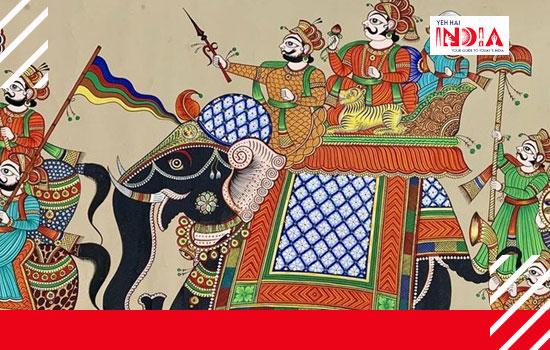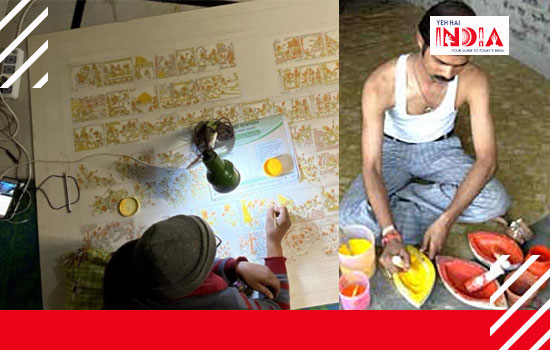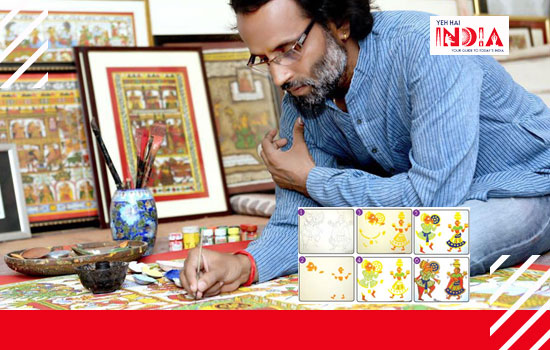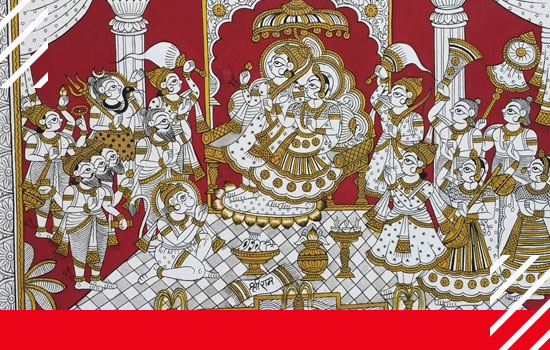India is a land of diverse cultures and all these cultures are endowed with their own art forms.
Each art form is unique in itself but all these art forms share a similarity: they all tell a story.
These ancient art styles have been passed down from one generation to the other and are still in practice.
Religious epics or Gods and Goddesses are depicted in each art form in spite of their uniqueness.
In ancient times, these art forms were made with natural dyes and colours made of soil, mud, leaves, and charcoal, on canvas or cloth.
Recommended Story – Where to Buy Authentic Tanjore Paintings?
Phad Painting

Shahpura Phad Painting also called ‘Phad’ is a type of religious scroll painting and folk painting practiced in the Shahpura, Rajasthan.
This style of painting is conventionally done on a 30 or 15 feet-long piece of cloth or canvas known as the Phad.
The narratives of the lives and heroic deeds of the folk deities of Rajasthan, mostly of Pabuji and Devnarayan are depicted on these Phads.
Phads are painted with vegetable colours.
The Phads of Pabuji are normally 15 feet in length while those of Devnarayan are about 30 feet long.
Origin of Phads

Phad painting originated in the year 1629 in Phoolia Estate Jagir, presently Shahpura, near Bhilwara, Rajasthan.
They are 700 years old.
This style of painting is an amalgamation of both the Rajput & Mughal styles of painting.
These Phads or scroll paintings are also known as Rajasthan’s travelling temples.
These were used as a song and dance performance by a pair of minstrels consisting of a priest and his wife called Bhopas and Bhopis.
They used these Phads to narrate stories of their local deities – Devnarayanji (a Gurjar warrior) and Pabuji (a folk deity) through their song and dance performance.
Each Phad painting tells a story in the form of a series of paintings.
These Phad paintings are unique as the figures always face each other.
None of the figures will ever face the onlooker and the eyes of the figures bring each character to life.
The size of each and every participant in the painting is different, depending on the role essayed by the person depicted in the story.
Phad painting would be unfolded only after sunset, and the song and dance performance are done in front of village members.
This is why these paintings are called ‘Phad’, which means ‘fold’ in the local dialect.
The Technique of Making Phad Paintings

Phad-making requires a little pre-preparation.
These are made on a khadi cloth that is soaked overnight to thicken the threads.
The cloth is then stiffened with starch made from glue and boiled wheat flour and stretched and dried in the sun.
After the sun dries the cloth, it is rubbed with a stone called ‘Mohra’ to smoothen and polish.
Rubbing the stone vigorously on the cloth gives it a sheen.
This cloth now becomes the canvas for painting.
Once this Phad is ready the painting is done with a lot of patience and precision.
Phad paintings are completely natural, as only natural fibres and natural paints sourced from stones, flowers, plants, and herbs are used.
The paints to be used are handmade by the artists and are mixed with gum and water before applying to cloth.
Recommended Story – How To Make The Majestic Tanjore Painting
Materials Required
- Brushes
- Phad (canvas)
- Natural Colours
Painting on Phad
Typical colours are used in a Phad painting which is yellow, orange, green, brown, red, blue, and black.
Each colour used has its own significance:
- Yellow for creating the initial outline and for jewelry, vessels, and instruments
- Orange for limbs and the torso and skin of the figures
- Green for trees and vegetation
- Brown for architectural structures
- Red for royal clothing and flags and a thick border
- Blue for water or curtains
- Black is applied in the end for outlining
Colour Making Techniques

All the colour pigments are ground by hand and mixed with water and gum.
- Light yellow (Pila, Hartal) is made from a yellow pigment.
It is used for sketching all the figures and structures.
- The orange or saffron colour which is used in painting faces and flesh is made by mixing red lead oxide (Sindur) with some yellow powder (Orpimat-Hartal).
- Green (Hara) is made from verdigris (Jangal) also known as copper acetate.
- Brown (Geru) is purchased from the market in powder form.
- Vermilion (Hinglu, Lal) is made by crushing chunks of cinnabar (mercury sulfide ore).
- Blue (Indigo) is easily available in the market
- Black (Kala, Syahi) is used in outlining the details of the figures.
It can be made in two ways either by burning coconut shells or by collecting the lampblack from burning edible oil.
Map Making
Once the cloth is ready to be painted, there is a ritual that the first stroke in the painting was always made by a virgin girl belonging to the painter’s family.
She makes a Swastika on the cloth with yellow colour and this ritual is known as “Chanka”.
After this ritual, the painter divides the canvas into various sections, according to the parts of the story being depicted.
This process is called map-making or making ‘Naksha’.
Colour Application

Once the map is made, the colour application is done.
- Firstly, the figures are drawn with a light hand, using a light pencil.
- Then accessories and clothes for the figures are drawn.
- The eyes are left for the end.
- Then the color application is done.
- All the figures are colored yellow in the initial stages.
- Then the dark colors are applied.
- Every inch of the canvas is used to create figures, flora and fauna.
- First, the saffron colour is applied to colour the skin of the figures
- Clothes are painted in green
- Bright yellow colour is used for the jewellery, vessels, and instruments.
- Royal blue for clothes detailing, including the designs and embroidery.
- The red colour is used for further detailing in the clothes and instruments.
- Then the eyes are painted which are the most important part of the painting.
- Lastly, a black outline is given to the entire picture using a thin brush.
- Pupils of the eyes are made after the completion of the painting as it was believed that once the pupil is drawn the painting comes alive.
- On an auspicious day, the painter completes the Phad
- The painter then signed in the central part of the scroll where the largest figure of Devnarayan/ or Pabuji was painted.
The Joshi families of Bhilwara, Shahpura in the Bhilwara district of Rajasthan have been practising this art for the last two centuries.
In the present day, Shree Lal Joshi, Nand Kishor Joshi, Prakash Joshi and Shanti Lal Joshi are the renowned artists of the Phad painting.
Also Read – Thangka Painting from Ladakh – The meditational Buddhist Artform










